For many visitors to India, the road from Goa to Hampi is a well-trodden path, a rite of passage for the seekers and pilgrims who flock to this “unearthly landscape that has captivated travellers for centuries.” (Lonely Planet).

Hampi is a UNESCO World Heritage Site which encompasses the ruins of one of India’s largest 14th century empires with kilometres of giant boulders, softened by emerald green rice paddies and banana plantations. In addition to being a holy site, Hampi is also the bouldering capital of India. Throw in yoga classes, ayurvedic treatments, and cheap guesthouses and the throngs of young tourists with their hennaed hands, baggy harem pants and bindi dots will follow. We saw the odd grey head wandering about, but we were older than most of our fellow travellers by at least 30 years. So far, no henna, but I have succumbed to purchasing a pair of harem pants. Photo to follow at some point.
The path to Hampi is not a straight one. All trains and buses arrive in Hospet – a dusty town about 15 km. from Hampi. This was our first glimpse of real India – and yes, those stories about cows (or in this case, water buffalos) holding up traffic are true.

Our tuk-tuk dropped us at the “ferry” – a small boat that transports passengers back and forth to the main guesthouse area in Hampi.

We had to remove our shoes to walk through five inches of water to board the boat and then again on the other side. The boat is filled to well beyond capacity; we loved that there was a single life jacket hung over the railing. Up the hill we trudged, past women washing laundry – a captivating first impression.
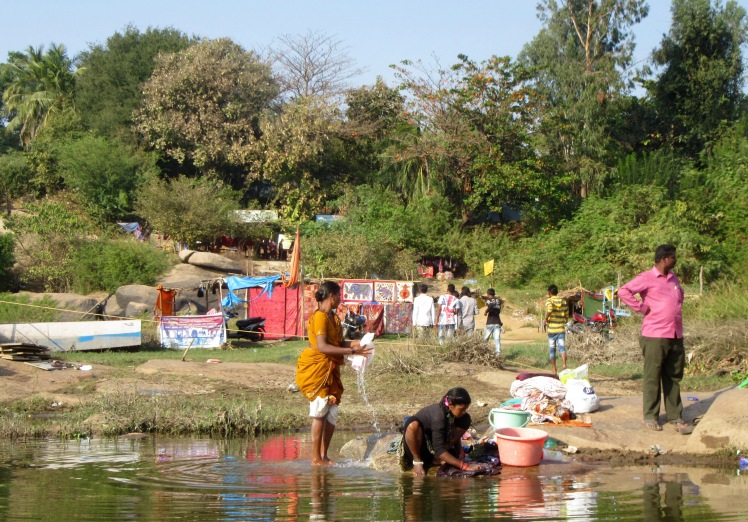
We then walked about a kilometre down the road until we arrived at our guesthouse – a less captivating experience. Our guesthouse had very mixed reviews on TripAdvisor, as did all the guesthouses – people like us are not their target market. There are areas in India where finding reasonable mid-range accommodation is challenging, and Hampi is one of them. Our room was dirty, we had no hot water, wifi disappeared after our first day, never to return – and no-one cared. We heard highly entertaining excuses for everything, with no solutions. Since the rest of our fellow travellers seemed unfazed, we tried to go with the flow, but my vivid imagination would not let go of the images of those who had slept before us on the stained sheets stretched over our hard, lumpy mattresses. Still, our guesthouse was in a gorgeous setting overlooking rice fields and this was the sunset on the first night.
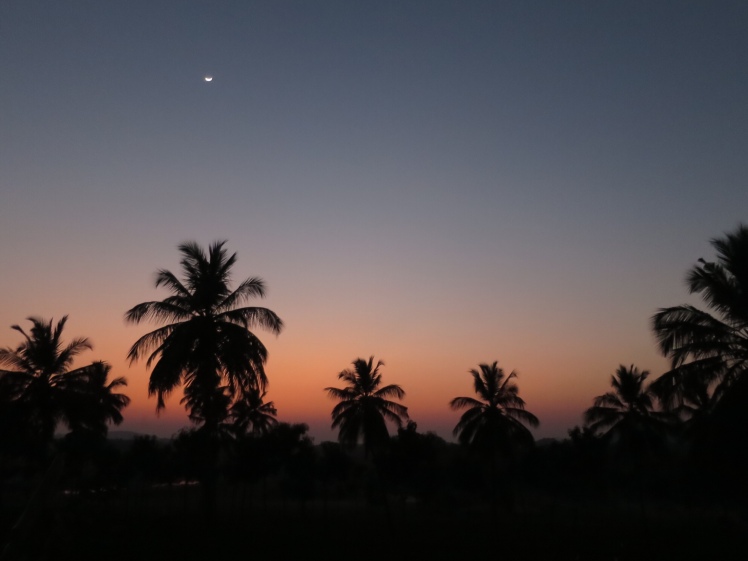
After much deliberating, we decided to rent a scooter the next day to see some of the sites that were close by. I was the one doing the deliberating because of a) the condition of the roads and b) my memory of the fatal accident last year in Laos. Stephen was raring to go, so we hopped on a scooter and took off with the rest of the helmet-less hordes.
Apparently I am a bad passenger, as I squirm around too much, so I was under strict orders to hang on and not move. Unlike the blasé Indian ladies riding sidesaddle and talking on their phones, I never entirely lost my nerves.

Still, it is the best way to get around and see the countryside. Stephen’s biggest challenge was dodging crater-like potholes and avoiding marauding trucks, so it wasn’t relaxing for him either. Along the way, we stopped a number of times for photos. I couldn’t resist this sweet little baby water buffalo.

Stephen couldn’t resist taking a brief video of me waving at a truckload of kids.
Our first stop was Hanuman Temple. We were met at the bottom by this crew of kids, who swarmed us for photos. This is very common in India – everyone wants a selfie with you and we have obliged dozens of times already.

Climbing the 575 steps up to Hanuman Temple is a pilgrimage for some; most devotees climbed the entire way in their bare feet.

We kept our shoes on until we reached the summit, and then removed them to walk around the outer perimeters. There are a number of monkeys up there and as long as you don’t feed them, they keep their distance. I’m not entirely comfortable around monkeys, so I was content to take photos from several feet away.

This view is the reward – a simply stunning panorama.

We were intrigued by this purified water stand, especially since our water bottle was almost empty. The Indians lined up to drink clean water, and they all drank from a single stainless steel cup! We shied away from this petri dish of communicable diseases.

The climb down was much easier, and we were treated to the sight of this woman arranging scarves and colourful clothes on nearby rocks. There were surprisingly few vendors and the ones we saw were quiet and respectful.
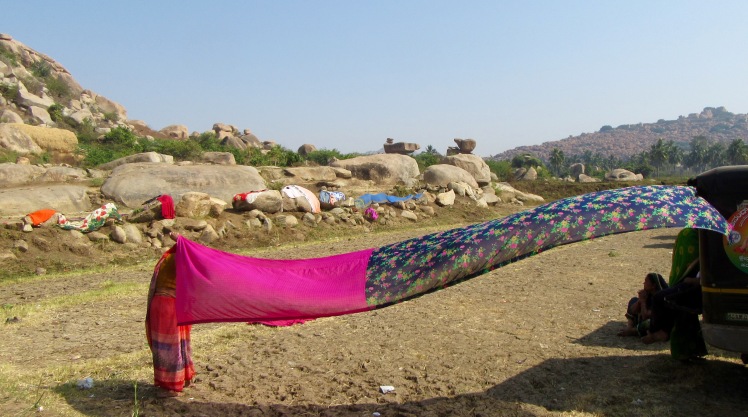
As we drove along, we noticed a young man on his motorbike who had stopped to take a photo and we pulled in behind him. There was a woman in the field tending to three cows, and as I noted to this young man, the image was like “something out of National Geographic”. Coincidently, he used to be a photographer for Nat Geo and has now been living in Bangalore for the past three years, working as a freelancer. He travels India looking for shots like this. I would love to see how his photos turned out.
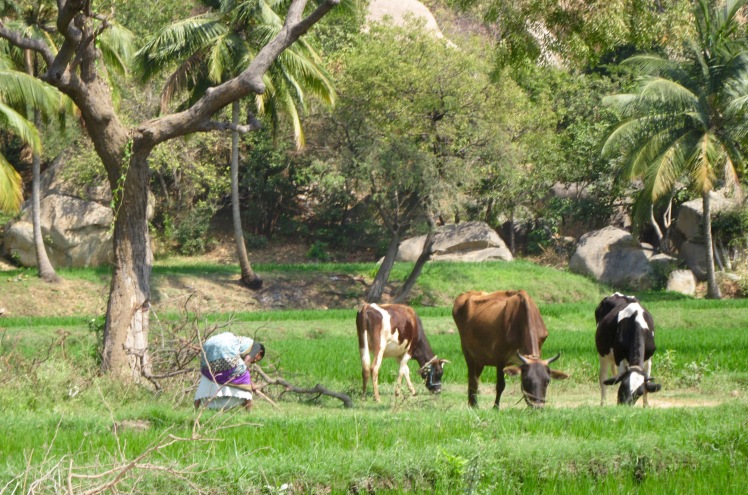
We drove by women working in the rice fields, planting rice to be harvested in a few months.

We were so struck by how hard so many Indians work, and for so little. Collecting and moving materials about – firewood, rice plants and hay.

Many children don’t go to school. We passed by this sad-eyed young boy, hauling his load of snacks and drinks on a heavy cart.

We arrived back to our guesthouse to see the resident Doberman in an absolute froth over the monkeys who were perched up on the rooftop, taunting him.

The next day we met up with Raghu, who took us out for a full day tour of the ruins on his tuk-tuk. Raghu was charming, knowledgeable and spoke perfect English, so we had a memorable time.

He is from Hampi and began by giving us an interesting overview of the town, before launching into the history of both the geology and the 14th century ruins. The ruins cover 26 square km. and it would take three more blog postings to cover it, so I’ll spare us all and just treat you to some photos.

More monkeys. Cute baby being cradled by a very protective mama.

We were the only ones visiting this temple and came across this woman who was camped out in the cool shade with her basket and some food and drink. She didn’t pay us any attention, but we were curious as to why she was there.

The military were out in full force, right up to ranked officers. They were happy to have their photos taken.

Three women heading into the fields in front of The Elephant Stable.

There were a number of women working the fields, turning the soil and pulling out dead grass with pickaxes. The stables in front of them used to house elephants.
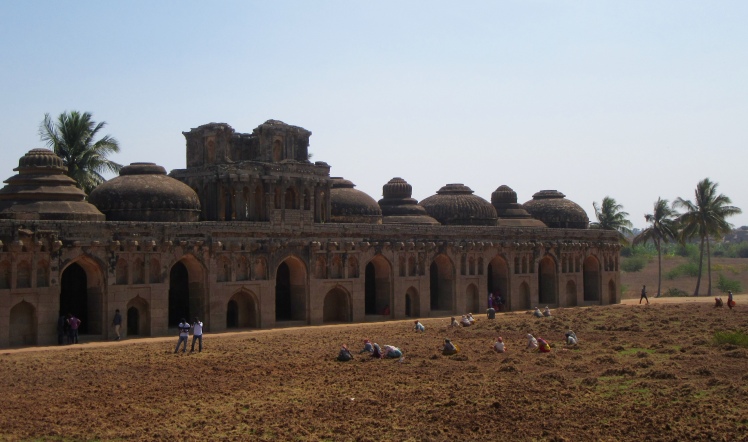
The Stone Chariot used to actually move – hard to imagine that now, and even harder to grab a pic without crowds of people in front. The elephants had been piled with kids all morning; this was a rare child-free moment.

I got almost as excited seeing this parrot as I did seeing the ruins.
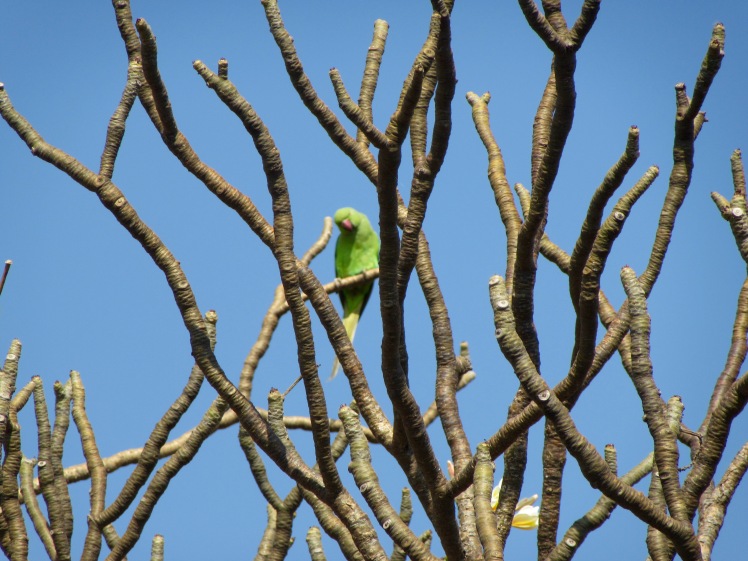
A school trip was in full swing just in front of me and as I was watching the parrot, I was being watched by young Indian boys, who demanded a photo.

The next thing I knew, their classmates had joined them.

Hampi is a magical, mystical place. I felt the beginning of a sense of India’s deep spirituality and symbolism there.
Now we’re in Mysore and will be back again in a few days.
Loving your journey!
LikeLike
So are we now – bumpy bus rides, dirty guesthouses and all!
LikeLike
Another interesting note but I’m afraid ti admit that I was a bit gagged by the description of your accommodations as in sheets.. Yikes! Loved the pics of the monkeys and the scenery is gorgeous. I look forward to the next chapter.
LikeLike
Ginny and Steve, I admire your pluckiness faced with such unattractive digs for your stay in Hempi. Your comment about the boat overstuffed with people but only 1 lifejacket reminds me of a story a friend told me years ago about a similar situation, but on open ocean in Mexico where they were snorkelling. When my friend mentioned the absence of sufficient life jackets and what would happen if the boat tipped over in the rough seas. With the fatalism of the East, he shrugged his shoulders and said (in Spanish), “Señora, many will die”. Looking forward to further travelogues.
LikeLike
Funny story. Once again, we are confounded with the contradictions of India – the sanctity of life on one hand combined with the utter recklessness on the other.
LikeLike
You are both so brave. Love the post.
LikeLike
It all balances out. We left behind squalor to our current hotel in Mysore – clean, huge room, comfy bed, loads of hot water. I think that will be our trip.
LikeLike
Hello you intrepid travelers! Haha! Guess what came to mind when I read your comments about the accommodations:The Best Exotic Marigold Hotel. Loving your posts. Traveling along with you xo
LikeLike
Oh, if only it was that charming! Weirdly enough, these are the things we’ll remember with a laugh later.
LikeLike
India is so exciting. I love revisiting all these places. Beware of monkeys, as they do tend to take things …like bags and cameras! I always admire them from a safe distance. You have no idea how your photos brighten up my grey, windy, wet day. Hugs
LikeLike
thanks Sheila – you will soon be heading to sun and colour yourself!
LikeLike
Another wonderful and intriguing post. Fascinating to me. Such a different culture. Thanks for sharing your travels with all of us back in Canada. Stay safe
LikeLike
We re-learned a necessary skill yesterday – how to cross a street without getting hit. We watched the locals navigate a roundabout and plunged in ourselves. I have no idea why it works, but it does.
LikeLike
Hampi sounds like the quintessential India we’ve experienced (although our travels have not yet taken us to Goa): classic accommodation, swarms of children demanding photos, amazing scenery with people in brightly coloured clothing working very hard, and divine food. Totally challenging and fascinating at the same time. You are surrendering and seem to be enjoying your adventure. We certainly are as we look out at the gray rain on Gabriola. Please keep sending sun-filled pictures and colourful descriptions of your trip.
LikeLike
Thanks Alison – you have no idea how handy the concept “surrender” has been. We’ve repeated it several times already. Incredible India – they are fulfilling their advertising slogan, to be sure.
We are fully engaged with India – not always the same thing as pure enjoyment, but that’s not why we’re here. We take all necessary steps to stay safe, not get hit by a truck, not get scammed ( it’s happened in a minor way twice already) and not get sick. With those steps in place, we can just take it all in – every single day brings an adventure.
LikeLike
To surrender…Freedom to become ALIVE! I’m loving this! Thank you!xoxo
LikeLike
Elsa, I think it is more of a survival tactic. But yes, ALIVE we are – all senses firing. We’re back in our room now recovering.
LikeLike
This blog is quite a contrast to your previous stop but that is one of the joys of travelling – something different around every corner. I loved your shot of the view from the top of Hanuman Temple … thanks for undertaking the climb for your readers! I noticed you mentioned the quiet manner of the vendors where you were. I am reminded of the story you told of the ones in S.E. Asia when you went on a day-long climbing trip in the mountains (with the women wearing flip-flops.). Quite a difference, wouldn’t you say? Finally, one would think you were a classroom teacher judging by the number of “class” photos you have taken! I love their smiling faces!
LikeLike
Heather, the kids here are so engaging and so openly curious about us foreigners. They yell out, “Hello!” (many times if that is the only English they know), or want their photos taken. Then they all giggle. My grey hair is a bit of a novelty for them – most older women here colour their hair. To watch them tear around on a school trip is a delight – they are joyous. But then, they are the lucky ones – they are going to school. It is the little kids who are not in school who are so sad to see – already their spirits are broken.
LikeLike
Such a turbulent and tranquil country, full of contrasts, and I’m still in awe of your pluck. Thanks for sharing Ginny, your writing is so lucid, photos are evocative and compelling. I’m right there with you. I agree about Steve’s shirt, he’ll fit right in…with the tourists! 🙂 Cheers, Garry
LikeLike